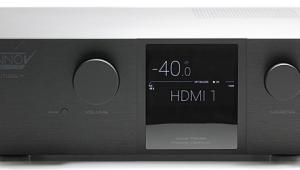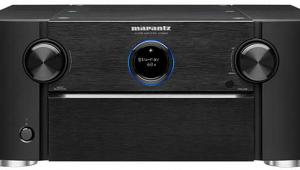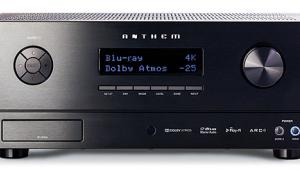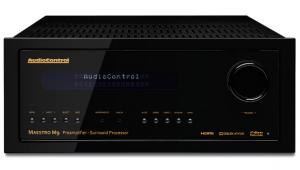Krell Foundation Surround Processor Page 2
The Foundation’s iPad remote is intended to also assist with setup and is said by Krell to be the reason the company skipped the onscreen display. When you use it, the Foundation’s front-panel readout is blacked out, and I found that some of the virtual buttons didn’t work and were fringed in blue, though Krell noted as we went to press (after I no longer had my sample) that the app is now working perfectly.
Navigating through the menu system can be frustrating. After I’d run the ARES program’s EQ function and not liked the attenuated bass, the only way I could remove the settings and return to audio ground zero was to restore all factory settings—and that’s after I’d named the inputs and configured inputs, outputs, and trigger functions. Perhaps there was an alternative method that wouldn’t have required complete setting erasure, but I couldn’t figure it out, nor did I see it in the sketchy instructions.
Breathtaking Sonic Performance That You Do Get
Switching to the Foundation from my moderately priced but sonically accomplished Marantz AV7005 and especially from the previously reviewed Integra DHC-60.5 was transformational. It was as if the entire system had been changed, including the Sonics By Joachim Gerhard speakers (now branded Canalis).
With the Foundation in place, you could stare down all five speakers (and the subwoofer) and not hear sound emanating from any of them. That is a high-performance audio quality rarely heard in commercial home theater, particularly from the usually easy-to-identify center-channel speaker.
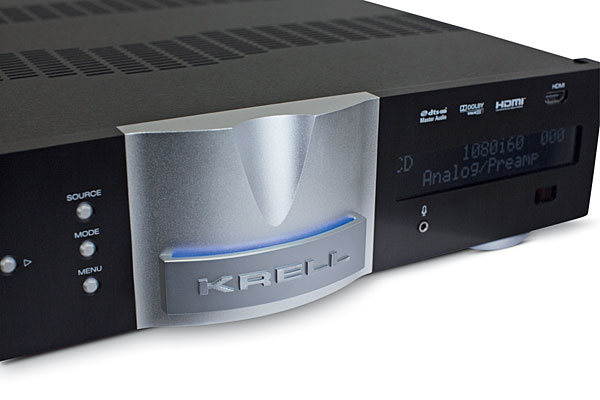
When watching local news becomes enticing because the anchor’s voice sounds so lifelike and transparent, you know something special is happening. What does that mean? Instead of metallic and/or boxy, muffled sound smeared against the speaker, a properly sized, three-dimensional, delicate, and transparent vocal bubble hovers in the same physical space occupied by the speaker.
The sonic attack is sharp and precise but not edgy or mechanical. That’s followed by a lifelike vocal sustain and an equally believable decay. Sibilants sound natural as they do in real life, though all of this is somewhat colored by what microphones—even the best ones—do to the human voice. But because it is timbrally coherent and the various events are timed perfectly, the result is a believable illusion, easy on the ears and overwhelmingly intelligible even at ultra-low sound levels.
The first movie I watched was the 3D edition of Life of Pi. It sounded as it looked: truly three-dimensional and not just due to the surround mix. Each channel’s delicate 3D sonic bubble, made up of individual 3D sonic elements, contributed to the floating sonic sensation. With all of these elements coherently merged in a single sonic bubble, the result was a giant, floating, shimmering, non-mechanical ether in the room approached but once before in my room by the even more minimalist Cary Audio 11a. The bubble’s borders extended well beyond all of the speakers’ physical boundaries, producing an enormous yet well-defined space, in which were placed solid yet three-dimensional images.
The Foundation lifted to exalted, billowy sonic heights Mychael Danna’s ethnically complex musical score filled with delicate, exotic Eastern percussive and wind accents as well as sweeping strings and familiar Franco-accordions. The Foundation maintained the clarity, dimensionality, and ease of even the most timbrally complex, dynamically challenging passages.
At one point, I chose to lie down on the couch. Despite the close proximity now to the left surround speaker, the room-filling 3D bubble maintained its integrity. I did not hear the left surround dominate, or in fact, the left surround at all. Instead, so three-dimensionally coherent and stable was the room bubble that the only change was a slight perspective shift.
The 192-kilohertz/24-bit Blu-ray Discs in Neil Young’s Archives Volume 1 box set reinforced the Foundation’s high-performance audio bona fides. On “Heart of Gold,” Kenny Buttrey’s kick drum approached the size, weight, and textural solidity I get on my big two-channel high-end rig downstairs. Of equal importance, the kick drum didn’t intrude into the physical or timbral space reserved for other instruments. Tim Drummond’s bass never merged with the kick drum to produce incorrect, amusical “mega-bass.” Young’s harmonica had an effervescent reediness and his voice an airy believability. You can easily and separately hear Linda Ronstadt’s and James Taylor’s background vocals.
On “Old Man,” the acoustic guitar’s metal strings ring, the snare on the left channel has that special live shimmer, and the echoey envelope surrounding the pedal steel floats in space. Young’s voice hovers believably.
Going back to my reference Marantz AV7005, good as it is for the money, produced a big let-down. Everything tamps downs spatially, harmonically, and texturally, airy reality quelled. What accounts for the Foundation’s sonic magic?
Technically, I cannot tell you, but I’m sure any person reading this could easily distinguish between the two renderings of these tracks—or more critically, not fail to be swept away and mesmerized by the Foundation’s sonically transportive qualities. Even the cable difference deniers (often also pre/pro sonic difference deniers) could easily distinguish between the Foundation and all (not most) of the less expensive mainstream competition.
Conclusion
If a relatively small company like Krell can produce these seductive, startlingly superior sonic riches, surely the big companies with their technological savvy and greater financial resources can too. For now, though, much to Krell’s relief, they seem to not be interested, perhaps believing that consumers aren’t either.
Yes, the Foundation’s user interface is clunky, and it doesn’t do much other than pass video and decode surround sound. You won’t get Pandora, Spotify, THX, and all of the other costly, licensed add-ons. Do you want swell gadgets or melt-in-your-ears sonics? During my evaluation period, I happened to listen to the Mobile Fidelity SACD version of Billy Joel’s “Say Goodbye to Hollywood” on my high-end two-channel system downstairs, then brought it up to listen on the Krell. I got upstairs much of what I got downstairs. Unlike every other “commercial” name-brand preamp/processor that’s passed through here, the Krell Foundation made me want to sit and listen. And that’s what it’s all about.
- Log in or register to post comments


Thank you for the article. I am intrigued particularly by your mention of the Cary 11. I've been considering the Cary Cinema 12 because it to seems to have superior sound quality, so I'm wondering how this Krell and the Cinema 12 would compare for sound quality.
With my current receiver, whose name will remain unwritten, I have to use the Oppo's analog out in 2 or 5.1 to get higher audio resolution.
The Oppo uses Sabre 32 Dacs and plays DSD 2 and 5.1 and if I'm reading the manual correctly (I just got it and am still in the new and explore stage) I have to use the analog out to get full audio resolution.
Would this Krell be fully compatible with the Oppo? Is it fair to ask you for a sound quality comparison with Marantz 8801 and Mac 121?
I'm interested in vinyl play back too!
It isn't easy, as a customer, to find these brands within a reasonable driving distance. Even when you do find them the rooms are set up so differently! I was recently in an audition room that seemed to totally deaden the audio, rolling off highs and lows creating an environment that to my ear didn't sound natural at all! The next listening room had little or no sound treatment. Wow what a contrast that was.
Thanks for any more info you can give.

The Krell does not incorporate a 5.1 channel input so for surround DSD you'd be out of luck unless you've misread the Oppo manual and its HDMI connection can output DSD (I do not know if that's possible) but you can run DSD two-channel into the Krell. As good as is the Marantz, the Krell is in a different league. Since the Mac 121 was reviewed as a complete system a comparison is impossible. That's about all I can say but I suspect the lack of 5.1 channel analog inputs will be a deal breaker for you. As for a Cary 12 comparison I can only compare to the Cary Cinema 11 and it was here a long time ago. It is certainly in the same "ball park" as the Krell but beyond that I can't say anything with certainly.

"You can run DSD decoded analog into the Krell, not DSD.

If you MUST have sources/integration/streaming like Spotify, Pandora, AirPlay, et al.... just patch-in an AVR for those features. If you are buying this pre/pro, you probably have the space and budget for seamless integration.
The point? When not using those sub-par formats, you get awesome audo and HT from the Krell and you can cheaply upgrade when new features arrive.
I bet, however, that a buyer pursuing this level of audio performance, has a dedicated HT and doesn't need those sources in that room. Perhaps they get them from distributed audio in other rooms?

Mr Fremer,
After re-reading your article I see you actually anticipated my questions about commercial brands such as Marantz and Macintosh, and I've answered my own question about Oppo compatibility.
I fully agree about redundant features. How many different pieces do I need that connect to Pandora and Netflix? Isn't the connectivity of apple tv, the panasonic tv, and the oppo blue ray player enough? None seem to have MOG:-(
Still, since this Krell combined with the matching Amp are too expensive for my budget, I am wondering about how the very well reviewed, on this website, Cary Cinema 12 stacks up to this piece.
Is there an amp less expensive then the Krell 7200 that would work well with this piece?
After reading your review I can't wait to hear the Foundation personally. Tomorrow I hope! If it sounds as spectacular as you indicated my wife may kick me out of the house...

My listening was with a Parasound Halo A51 that you can get for around $4500. The Krell 7200 may be better (or not!) but the combo I reviewed is missed here every day. Well I have the amp….

Mr. Fremer, Thank you for your comments about the Krell Foundation, Cary 12 etc:
Thought you’d be interested in Krell’s response to my question about DSD:
Thanks for your communication and also for your interest in the Krell Foundation preamp/processor. At some point later on this year, most likely coinciding with the implementation of 4K in the Foundation, the Foundation will also get the ability to decode a DSD signal via HDMI. We do not have an exact time line for when this will occur but it is something that we are working on right now.

Hey. Anyone have any suggestions as to the best cables to use for the krell pre-pro setup? I'm looking for best performance on the upper-end price point (not the super budget or budget cables, but not cost is no object either). Also, it would be great if you added a top picks for cables to go along with the a/v equipment. Thank you.

